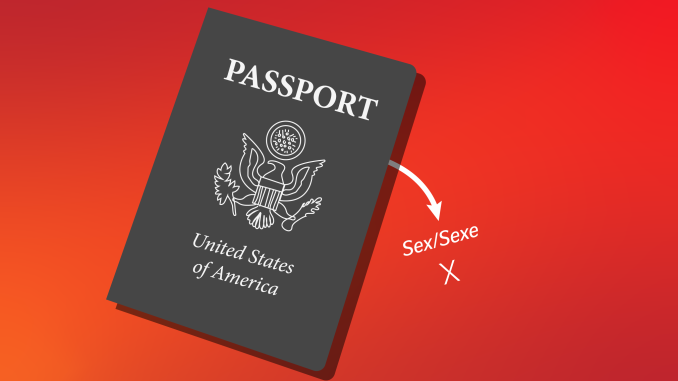
On Oct. 27, the United States Department of State announced it issued the first passport with an “X” gender marker, which represents non-binary, intersex or gender non-conforming people. The “X” gender marker will become an option for all U.S. passport applicants in 2022, CNN reported.
Pennsylvania made the “X” gender marker an option for driver’s licenses in 2020. Pennsylvanians who already have driver’s licenses can change their gender marker by completing a DL-32 Form, which allows residents to make a request for gender change on their driver’s license or identification card, and bringing it to a PennDOT Driver’s License Center, according to the PennDOT Driver & Vehicle Services website.
It is monumental for more people to have their gender affirmed on official identification documents through the expansion of the “X” gender marker. Even so, gender markers should be entirely removed from passports and other forms of identification because they serve no real purpose, and potentially leave people vulnerable to discrimination. If gender markers remain in place, people should be given the option not to provide their gender.
Heath Davis, a political science professor and director of the Intellectual Heritage program, questions the need for gender and sex categories in identification documents, bathrooms and college applications.
“I think the X marker is a way of recognizing people who identify as non-binary or intersex, but I would love to see us go a step further and remove the gender markers altogether from passports and other identification documents,” Davis said. “They’re not really necessary when you think about the purpose of these documents to identify us personally, and there are better ways to do that.”
However, the International Civil Aviation Organization, an organization within the United Nations that recommends and helps establish air traffic standards, has argued that updating border patrol software to remove the gender category would cause a reduction in some border authorities’ ability to run risk-assessments on travelers based in part on gender.
Although there can be costs associated with removing gender markers, the ICAO also claims that incorrect gender markers have caused confusion for border authorities, making them ineffective. In addition, they already use face-recognition technology to match identification documents with database records and are adding more biomarkers, such as fingerprints and iris scans.
A person’s gender cannot be assumed from appearance. Gender does not determine the different clothes, makeup, accessories and hairstyles people are allowed to wear. Gender identity is not determined by other people’s perceptions.
In June 2021, the American Medical Association recommended removing sex assignments from the public portion of birth certificates because assigning a baby as either male or female does not acknowledge the full medical spectrum of gender identity, which recognizes intersex or non-binary people. Instead, information about a baby’s sex would only be visible to medical professionals.
As the largest national medical association in the U.S., the AMA’s recommendation demonstrates that gender and sex markers are unnecessary, and even harmful, on identification documents.
In a 2015 survey by the National Center for Transgender Equity, 68 percent of transgender adults reported not having their correct name or gender on any identification document. Thirty-two percent of respondents who had shown a form of identification with a name or gender not matching their gender presentation were verbally harassed, denied benefits or service, asked to leave or assaulted.
The Southeastern Pennsylvania Transportation Authority eliminated gender markers from their weekly and monthly commuter passes in 2013. Previously, the passes included male and female markers.
SEPTA’s removal of gender markers came after the Riders Against Gender Exclusion — a group of transgender, genderqueer and gay individuals — pressured the transportation agency by protesting and collecting testimonials and petition signatures. The group formed in 2009 to protest the discrimination that Charlene Arcila, a transgender woman, experienced in 2007 because of the gender marker listed on her commuter pass, which prevented her from using her SEPTA Transpass with her preferred gender listed.
SEPTA’s decision to remove gender markers from transit passes is a step towards removing them from other identifying documents because they do not confirm people’s identities and can put people that don’t match their listed gender marker at risk of prejudice.
Whether it’s a driver’s license or a passport, removing gender markers from identification eliminates the discrimination people face as all that should be necessary is matching your identification picture, said Brad Windhauser, a professor in the English and Gender, Sexuality and Women’s Studies departments.
Further, adding an “X” gender marker option for identification documents does not remove the male and female markers currently in place. This could create a gender ternary — a system with three gender categories — instead of expanding people’s ideas of gender beyond any rigid systems.
Adrien Van Voorhis, a sophomore political science and history major, has an “X” marker on their driver’s license, but has since changed their views on gender markers, now advocating for their removal, they said.
“I don’t think that my individual affirmation is worth buying into a system that perpetuates these sort of markers and that perpetuates a two-category or three-category gender system,” Van Voorhis said.
Even though gender markers can give individuals a sense of affirmation, they are not useful for identification purposes and are better off being eliminated from identification documents.
“I think for a lot of [cisgender] people, it’s not something we’ve ever been asked to think about when it’s on our driver’s licenses or state-issued IDs or some box we check,” Windhauser said. “People have just always assumed that this is no big deal and the idea of having it was sort of just a given.”


Be the first to comment